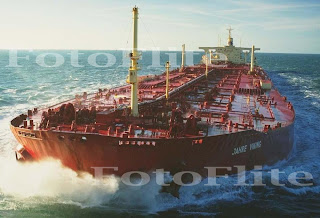
Knock Nevis/Jahre Viking : Worlds largest moving object!!!!!!!!!!!!







Welcome aboard the TT Jahre Viking, a ship so huge that when fully laden she can not pass through the 32-mile-wide English channel that separates England from France, what to speak of the Suez and Panama canals. For, when laden, she sits 24.6 meters in the water, a depth great enough to deny her entry to most of the worlds major ports.
EVEN in an age of superlatives, she continues as the ultimate superlative, a ship so huge that she would comfortably swallow up Indias largest ship, the 25,000-tonne aircraft carrier INS Vikrant, in her holds. On land, at 485.46 meters from tip to tip, she would dwarf the worlds tallest man-made land structure, the 424-metre Petronas tower of Malaysia. At sea she is fully 100 per cent bigger than the new breed of competing super tankers like the ill-fated Exxon Valdez.
A brief history of Jahre Viking
But, perhaps, proving the old adage that its lonely at the top, life hasnt exactly been bed of roses for this giant which defies classification (in shipping parlance she has been dubbed ULCC, an ultra large crude carrier). Built in 1979 for a Greek shipping magnate towards the fag end of the super tanker boom that followed the oil embargo of 1973, her original owner went bankrupt even before she put out to sea. Following this her builders, the Japanese conglomerate Sumitomo offered her to a Hong Kong owner.
But before taking delivery, her new owner set an unusual condition. Already massive at 480,000 tonnes, he ordered that her length be increased several more meters to add another 87,000 tonnes to her load-carrying capacity to make her, at 564,763 tonnes, the largest ship to ever be built.
Two years later, in 1981, she was finally ready to be put to sea under the name the Sea Wise Giant.
As the timing goes, her launch was not without hassles. Unfortuitous. Two major oil-producing states of Iran and Iraq were locked in a bitter war, and with the Arab world believed to be bankrolling if not actually backing Iraq, any ship carrying Iranian or Arab oil (in effect every tanker playing the Persian Gulf, the source of most of the worlds oil), was seen as a legitimate military target by the other country.
Against this backdrop it was too much to expect the Sea Wise Giant to sail without hindrance. Still, for the first few years of her life she plied her trade unmolested in the Gulf of Mexico, even doubling as a storage tanker, ill fate propelled her towards a more active duty in the Persian Gulf, and transformed her into a sitting duck for would-be takers.
As expected, disaster struck soon enough. While sailing the Hormuz Straits in 1986, she was targeted by Iraqi jets, who fired their full complement of Exocet missiles into her hull. The Sea Wise Giant never had a chance. Extensively damaged, she sank in the shallow waters off Irans Kharg Island.
Here she would sit out for the remainder of the war. And might have sat indefinitely had it not been for her uniqueness and what maritime assessors saw as her enduring value. The Sea Wise Giant, or what remained of her, was bought by a Norwegian company, re-floated, and towed to the Keppel shipyard in Singapore. After major conversions and repairs she was re-launched in 1991 as the TT Jahre Viking, quite simply the largest ship that set sail again.
But although she now regularly sails into the sunset, parting the seas before her as she goes, life is still not bed of roses aboard the Jahre Viking. To quote KPS Kang, a Chandigarh youth, back after a stint as Chief Officer aboard her. "When you work as Chief Officer on the worlds biggest ship your responsibilities are bigger in every sense of the word". In his case it meant looking after cargo, discharge and maintenance of 46 tanks and 31,541 square meters of deck.
At sea, especially when negotiating rocky straits and shallow waters, the need for constant depth current monitoring is that much greater. And at port, or what substitutes as port, single-buoy moorings in the open sea or ship-to-ship transfer of cargo entail a lot of risk. The risk of accidents or spillage is much higher than with ships working out of safe harbours.
In tacit recognition of this and her sheer size, the Jahre Viking has been designated in the class of worst-case scenarios by the US Coast Guard, prompting strict international monitoring and compensatory vigilance on the part of her crew and a goodbye to the occasional perk like a Singapore sling to a setting tropical sun. (Following the Exxon Valdez disaster off the coast of Alaska blamed on its drunken captain; most tankers adopted a no-alcohol policy).
Surprisingly, for a ship her size, the Jahre Viking packs in a rather small crew of 40, about the same number as aboard two Air India Jumbos. And all of these are of non-Norwegian origin. In fact, barring the occasional Russian junior officer, all officers, including her captain, are Indians. The crew is almost entirely Filipino.
In March 2004, the Jahre Viking was sent by its new owner, Fred. Olsen Production a.s (FOP), wholly owned subsidiary of First Olsen Tankers, to the shipyard Dubai Dry-docks to be refitted as a floating storage and offloading unit ("FSO")
There, it was given its current name, Knock Nevis. The ship now operates as an FSO at the Al Shaheen oilfield in the waters of Qatar.


No comments:
Post a Comment